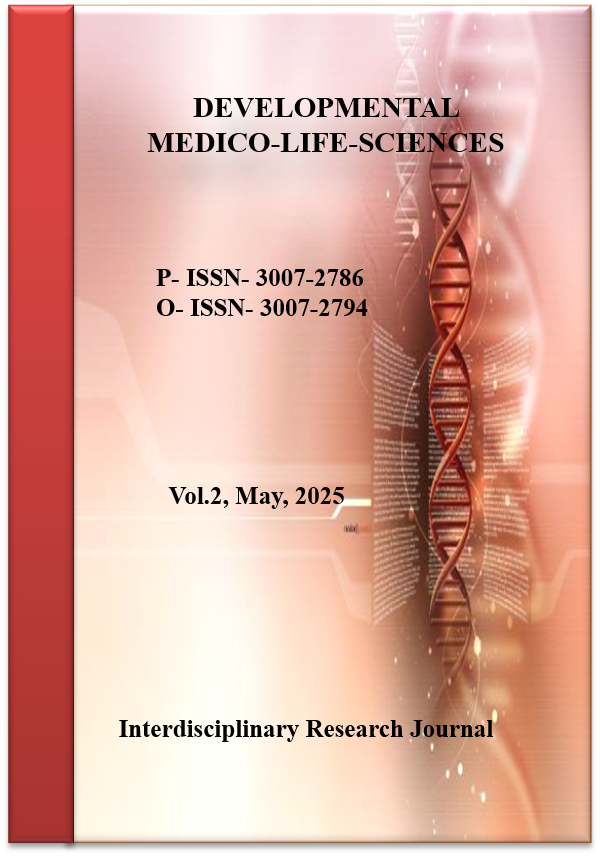Correlation Between Retinal Nerve Fiber Layer Thickness and Cognitive Decline in Elderly Patients Using Optical Coherence Tomography (OCT)
Retinal Nerve Fiber Layer Thickness, OCT, and Cognitive Decline
DOI:
https://doi.org/10.69750/dmls.02.05.0124Keywords:
optical coherence tomography, retinal nerve fiber layer, cognitive decline, Alzheimer’s biomarkers, elderly, PakistanAbstract
Background: Dementia and mild cognitive impairment are rising concerns in Pakistan’s aging population, yet access to conventional neuroimaging and cerebrospinal fluid biomarkers is limited. Retinal imaging via optical coherence tomography (OCT) offers a non-invasive window into central nervous system health, with thinning of the retinal nerve fiber layer (RNFL) proposed as an early indicator of neurodegeneration.
Objective: To assess the relationship between peripapillary RNFL thickness as well as related retinal and systemic biomarkers and global cognitive function in elderly Pakistani patients.
Methods: In this cross-sectional study, 120 participants aged 65 years or older were recruited from Syed Eye Care (Bahawalpur) and Allied Hospital II (Faisalabad) and stratified by Mini-Mental State Examination score into cognitively normal (n=40), mild cognitive impairment (n=40), and dementia (n=40) groups. Spectral-domain OCT measured average and quadrant-specific RNFL thickness, ganglion cell–inner plexiform layer thickness, and central macular thickness. Blood samples were analyzed for Alzheimer’s biomarkers (Aβ₄₂, total tau, phospho-tau), inflammatory marker (C-reactive protein), and vascular risk factors (homocysteine, cholesterol). Group comparisons utilized one-way ANOVA, and associations with cognitive scores were evaluated using Pearson correlation.
Results: Average RNFL thickness decreased progressively from 89.1 ± 4.7 µm in controls to 81.7 ± 5.2 µm in mild cognitive impairment and 72.4 ± 4.5 µm in dementia (p < 0.001). Similar graded reductions were observed in ganglion cell–inner plexiform layer and central macular thickness (all p < 0.001). Blood Aβ₄₂ declined and tau species, C-reactive protein, homocysteine, and cholesterol increased significantly across cognitive groups (p < 0.01). Temporal RNFL thickness demonstrated the strongest correlation with cognitive performance (r = 0.66, p < 0.001).
Conclusion: OCT-derived retinal measures, particularly temporal RNFL thickness, correlate strongly with cognitive impairment and systemic Alzheimer’s and vascular biomarkers in Pakistani elders. OCT screening may serve as a practical, non-invasive adjunct for early detection of neurodegenerative change in resource-limited settings.
Downloads
References
Ko F, Muthy ZA, Gallacher J, Sudlow C, Rees G, Yang Q, et al. Association of retinal nerve fiber layer thinning with current and future cognitive decline: A study using optical coherence tomography. JAMA Neurol. 2018;75(10):1198–205. doi:10.1001/jamaneurol.2018.1578
Oktem EO, Derle E, Kibaroglu S, Oktem C, Akkoyun I, Can U. The relationship between the degree of cognitive impairment and retinal nerve fiber layer thickness. Neurol Sci. 2015;36(7):1141–6. doi:10.1007/s10072-014-2055-3
Kim HM, Han JW, Park YJ, Bae JB, Woo SJ, Kim KW. Association between retinal layer thickness and cognitive decline in older adults. JAMA Ophthalmol. 2022;140(7):683–90. doi:10.1001/jamaophthalmol.2022.1563
Girbardt J, Luck T, Kynast J, Rodriguez FS, Wicklein B, Wirkner K, et al. Reading cognition from the eyes: association of retinal nerve fibre layer thickness with cognitive performance in a population-based study. Brain Commun. 2021;3(4):fcab258. doi:10.1093/braincomms/fcab258
Zhang JR, Cao YL, Li K, Wang F, Wang YL, Wu JJ, et al. Correlations between retinal nerve fiber layer thickness and cognitive progression in Parkinson's disease: A longitudinal study. Parkinsonism Relat Disord. 2021;82:92–7. doi:10.1016/j.parkreldis.2020.11.025
Lian TH, Jin Z, Qu YZ, Guo P, Guan HY, Zhang WJ, et al. The relationship between retinal nerve fiber layer thickness and clinical symptoms of Alzheimer’s disease. Front Aging Neurosci. 2020;12:584244. doi:10.3389/fnagi.2020.584244
van Koolwijk LME, Despriet DDG, Van Duijn CM, Oostra BA, van Swieten JC, de Koning I, et al. Association of cognitive functioning with retinal nerve fiber layer thickness. Invest Ophthalmol Vis Sci. 2009;50(10):4576–80. doi:10.1167/iovs.08-3181
Gao L, Liu Y, Li X, Bai Q, Liu P. Abnormal retinal nerve fiber layer thickness and macula lutea in patients with mild cognitive impairment and Alzheimer's disease. Arch Gerontol Geriatr. 2015;60(1):162–7. doi:10.1016/j.archger.2014.10.011
Knoll B, Simonett J, Volpe NJ, Farsiu S, Ward M, Rademaker A, et al. Retinal nerve fiber layer thickness in amnestic mild cognitive impairment: Case–control study and meta-analysis. Alzheimers Dement (Amst). 2016;4:85–93. doi:10.1016/j.dadm.2016.07.004
Almeida ALM, Pires LA, Figueiredo EA, Costa-Cunha LVF, Zacharias LC, Preti RC, et al. Retinal neural loss by swept-source OCT correlates with cognitive impairment in mild cognitive impairment. Alzheimers Dement (Amst). 2019;11:659–69. doi:10.1016/j.dadm.2019.08.006
Méndez-Gómez JL, Rougier MB, Tellouck L, Korobelnik JF, Schweitzer C, Delyfer MN, et al. Peripapillary retinal nerve fiber layer thickness and evolution of cognitive performance in an elderly population. Front Neurol. 2017;8:93. doi:10.3389/fneur.2017.00093
Shen Y, Shi Z, Jia R, Zhu Y, Cheng Y, Feng W, et al. Attenuation of retinal nerve fiber layer thickness and cognitive deterioration. Front Cell Neurosci. 2013;7:142. doi:10.3389/fncel.2013.00142
Jindahra P, Hengsiri N, Witoonpanich P, Poonyathalang A, Pulkes T, Tunlayadechanont S, et al. Evaluation of retinal nerve fiber layer and ganglion cell layer thickness in Alzheimer’s disease using OCT. Clin Ophthalmol. 2020;14:2995–3000. doi:10.2147/OPTH.S276625
Shi Z, Cao X, Hu J, Jiang L, Mei X, Zheng H, et al. RNFL thickness is associated with hippocampus and lingual gyrus volumes in nondemented older adults. Prog Neuropsychopharmacol Biol Psychiatry. 2020;99:109824. doi:10.1016/j.pnpbp.2019.109824
Ito Y, Sasaki M, Takahashi H, Nozaki S, Matsuguma S, Motomura K, et al. Quantitative retinal OCT assessment and associations with cognitive function. Ophthalmology. 2020;127(1):107–18. doi:10.1016/j.ophtha.2019.05.021
Liu D, Zhang L, Li Z, Zhang X, Wu Y, Yang H, et al. RNFL thinning in mild cognitive impairment and Alzheimer’s disease. BMC Neurol. 2015;15:14. doi:10.1186/s12883-015-0268-6
Laude A, Lascaratos G, Henderson RD, Starr JM, Deary IJ, Dhillon B. RNFL thickness and cognitive ability in older people: Lothian Birth Cohort 1936 study. BMC Ophthalmol. 2013;13:28. doi:10.1186/1471-2415-13-28
Méndez-Gómez JL, Pelletier A, Rougier MB, Korobelnik JF, Schweitzer C, Delyfer MN, et al. RNFL thickness and brain alterations in visual/limbic networks in adults without dementia. JAMA Netw Open. 2018;1(7):e184406. doi:10.1001/jamanetworkopen.2018.4406
Sánchez D, Castilla-Marti M, Rodríguez-Gómez O, Valero S, Piferrer A, Martínez G, et al. Peripapillary RNFL thickness as a biomarker for Alzheimer’s disease. Sci Rep. 2018;8(1):16345. doi:10.1038/s41598-018-34577-3
Cunha LP, Lopes LC, Costa-Cunha LVF, Costa CF, Pires LA, Almeida ALM, et al. Macular thickness by OCT for retinal neural loss and correlation with cognitive impairment in Alzheimer’s disease. PLoS One. 2016;11(4):e0153830. doi:10.1371/journal.pone.0153830






















